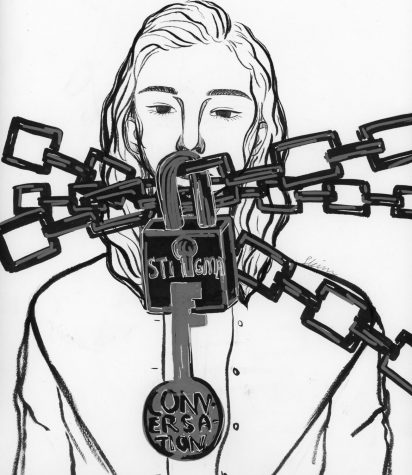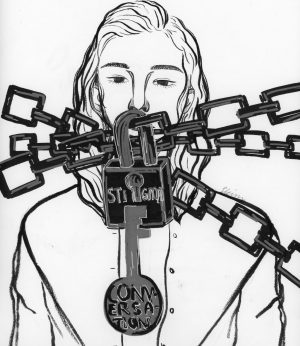Destigmatizing the period: the pink tax
April 2, 2019
In 2015, President Trump commented on Fox News anchor Megyn Kelly, referring to menstruation, to CNN’s Don Lemon, “You could see there was blood coming out of her eyes. Blood coming out of her wherever.”
Rhetoric like this further stigmatizes menstruation, causing the issues that come with it to receive little limelight in a political landscape dominated by males. The end result is a world where “that time of month” becomes an excuse for marginalizing half of the population.
Even in the U.S., 37 states, including progressive California, currently tax feminine products such as tampons, otherwise known as the luxury/pink tax. The tax indicates that these items are a luxury, when they are essential to the normal continuation of every female’s life. If just California alone were to exempt feminine hygiene products from tax, $20 million would be saved per year for consumers — $20 million that would increase affordability for numerous Americans daily.
While the difference in price may be marginal in upper-class areas, menstruation and a lack of access to sanitary napkins can cause perpetual homelessness, forcing women to choose between food and hygiene products.
For the 42 million women in the U.S. that live in or are close to poverty and rely on public infrastructure on a day to day basis, government funding continuously fails them. Welfare programs, which have traditionally been the backbone of homeless communities, are overwhelmingly unaccommodating of menstruation. Government grants for shelters often exclude funding for menstrual napkins. Even numerous inner-city and rural schools, as well as public restrooms, have available free condoms, but not everyday necessities such as tampons and pads.
Access to menstrual products is more than a question of comfort, but often one of life and death. When women don’t have dependable access to hygenic menstrual products, they turn to either reusing or substituting sanitary napkins, which can often be fatal. Numerous studies have established the strong causal link between unhygienic menstrual habits, driven by a lack of consistent access to menstrual products, and medical conditions as serious as cervical cancer.
Opponents argue that eliminating the pink tax would cause governments to lose revenue, possibly leading to cuts in various programs. However, tax revenue is meant to fund government efforts to better the lives of citizens. If anything, repealing the pink tax short circuits the miles of red tape that would accompany any government program to increase accessibility to sanitary napkins.
This is not to say that there hasn’t been tremendous progress, as some state governments and as social media movements have worked to eradicate unfair government policies. But this simple bodily function still remains a barrier worldwide to upward mobility and represents a primary obstacle in independence, further limiting women around the world and entrenching patriarchal taboos deeper into society.
What likely makes the change so slow and gradual, however, ties into menstruation education in schools. Health curriculum generally isolates the issue as a “girl thing.” The effect is a segregated discussion, one where most men rarely participate, not because they don’t care, but because they have been taught that it doesn’t concern them. How can we expect urgency and priority to be given to an issue that half our population doesn’t understand?
The mentality that menstruation is isolated to only women not only stigmatizes and alienates the issue further, but also decreases the chance that legislative action is taken. President Obama explained in an interview with YouTuber Ingrid Nilsen that much of the reason sanitary napkins are still taxed as luxury products is because male politicians often don’t understand the impact. And our national policies are projections of this misunderstanding.
A prime example can be seen in welfare programs. Medicaid and SNAP (food stamps), among other government programs, exclude menstrual products from their list of services despite sanitary napkins having status as “medical products” under the FDA. Rather, these programs place them under the bucket of “luxury items,” right alongside pet food and alcohol. The classification of much needed hygiene products as “luxury items” is emblematic of the disconnect between our politicians and the constituents.
We shouldn’t be surprised. The underlying driver of social change has traditionally been a need to see a difference. The already slow wheels of government, amid some of the highest levels of polarization in our country has seen, are further bogged down by a lack of understanding.
Making all genders, regardless of their personal experience with menstruation, comfortable with discussing it translates to a greater societal acknowledgment of the issue, an essential part of spurring change and establishing the idea that menstrual hygiene is a problem everyone should care about.
Critics of inclusionary health education often argue that young boys are too immature to handle serious conversations and would only make girls feel uncomfortable. However, without health education from a reliable source, boys end up receiving false information, that, if anything, further stigmatizes the issue. If either way, young boys will be exposed to the concept of menstruation, it is significantly better that information comes from teachers and school sponsored curriculum.
Others also contend that including males in discussions surrounding menstruation would result in backlash from the local community, especially in rural and less progressive areas where even health programs promoting alternatives to abstinence are met with heavy criticism. However, the duty of the school system is not to the parents but to its students. Rather than adapting the curriculum to fit the ideologies of past generations, schools must utilize education as the powerful tool it is and shape the mindsets of individuals to become more accepting of menstruation and its implications for women everywhere.
Of course, the fastest and easiest way to start making change is to communicate. Nearly every movement in history is sparked by discourse, a tool that we too should utilize. Campaigns such as #Bloodnormal are destigmatizing menstruation by encouraging the issue to not be isolated to a single gender, thereby normalizing it and combating the associated stereotypes of “impurity.”
In the long run, policymakers should take action to ensure that factually correct and inclusive health education is available, as well as eliminate the pink tax. But the wheels of change move slowly, and until sizable progress can be seen throughout the world, it’s important it starts with us.













